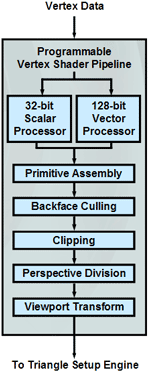ATI’s Radeon 9700 (R300) – Crowning the New King
by Anand Lal Shimpi on July 18, 2002 5:00 AM EST- Posted in
- GPUs
Vertex Processing – Twice GeForce4’s Triangle Throughput
Now that the GPU knows what data it needs to begin processing and what it needs to actually do to this set of data, it starts working. The data sent to the GPU is sent in the form of the vertices of the polygons that will eventually be displayed on your screen. The first actual execution stage in the graphics pipeline is what has been referred to as T&L for the longest time. This is the transformation of the vertex data that was just sent to the GPU into a 3D scene. The transformation stage requires a lot of highly repetitive floating-point matrix math. Next comes the actual lighting calculations for each of these vertices. In a programmable GPU these initial vertex processing stages are very flexible in that short vertex shader programs can be written to control a number of the characteristics of the vertices to change the shape, look or behavior of a model among other things (e.g. matrix palette skinning, realistic fur, etc..).

The R300 features four programmable vertex shader pipelines, much like the Matrox Parhelia. The difference between the R300 and the Parhelia is that the R300 has a much improved triangle setup engine, so while the Parhelia can boast incredible vertex throughput rates, the GPU is still limited by its triangle set-up engine. This reason is why, in games with very low triangle counts, that the Parhelia was not able to outperform even the GeForce4 with fewer vertex shader pipelines; with a triangle set-up engine no more powerful than the GeForce4’s, and running at a lower clock speed, the Parhelia did not have the triangle throughput power to backup its vertex shader pipelines.

ATI fixed this problem with the R300, and it is able to offer a triangle throughput rate of over 300M triangles per second. Compared to a GeForce4 Ti 4600, this is over twice the triangle throughput which you would expect considering that the R300 has twice as many vertex shader pipelines.
This is the first area in which the R300 truly begins racking up its performance advantage. ATI’s HyperZ technology also comes into play here, but we will save that for its own page explaining the technology.










0 Comments
View All Comments